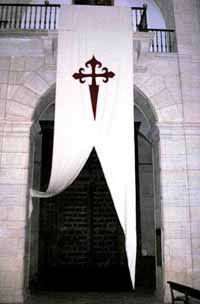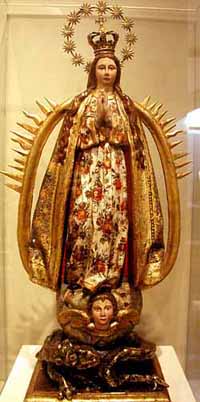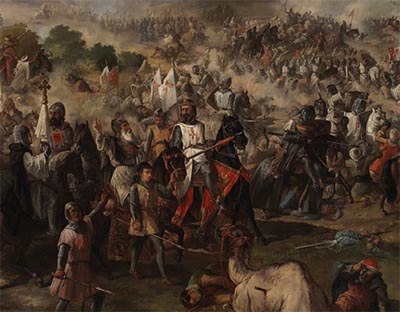 |
Stories & Legends
The Knights of St. James of the Sword
Hugh O’Reilly
The Order of Santiago, also known as the Order of St. James of the Sword, was founded in 1170 under the reign of Ferdinand II, King of León and Galicia. It began as an order of knights to protect the pilgrims traveling to Compostela to visit the sepulcher of St. James from attacks by the Moors.

The cross shaped as a sword of the Order of St. James |
In the beginning, the canons of St. Eloy, who had a monastery in Galicia, constructed hospices along the road to Compostela called Via Francisca to lodge the pilgrims along their journeys. Some time later, 13 knights, taking St. James as their patron, made a vow to guard and protect the roads to Compostela from attacks by the infidels.
They joined together with the canons of St. Eloy in 1170 to live under a common rule inspired by that of St. Augustine. Pope Alexander III recognized it as a religious military order in the papal bull Benedictus Deus.
To be received as a new knight
To be received as a knight of Santiago, it was necessary to prove nobility of blood for four generations on the paternal as well as maternal sides. The postulant could not have any ancestors who were Jewish, Saracen or heretical, or had been condemned by the Tribunal of the Inquisition. These proofs were presented before a canon and a knight of the Order.
If they were approved by the Council of the Order, the neophyte received the habit from a person named by the King. The novices were obliged to serve in the galleys for six months, and afterward they remained another month in a monastery to learn the Rule.
The vow to defend the Immaculate Conception
In their early history, the knights were regular religious who took the three vows of obedience, poverty and chastity.

La Imaculada in the Church of St. Pelagius in Santiago, Spain |
Later, Pope Alexander III permitted that married men could also enter, taking the vow of conjugal chastity. In 1652, a fourth vow was added, that of defending the Immaculate Conception of the Virgin.
The Orders of Santiago, Calatrava and Alcântara all added this fourth vow, making the decision in their respective General Chapters of that year. The knights made the fourth vow publicly in a grand ceremony. Novenas were made in Madrid in three different churches, magnificently adorned. Each day of the novena the mysteries of the Conception were preached; at the end of the nine days, a solemn Pontifical Mass was celebrated by the Priors of the three Orders and by the Abbots of the Orders of St. Benedict and the Cistercians.
In each of the churches, the knights appeared in their ceremonial habits. After the Gospel of the Mass, a knight pronounced the vow in a loud voice, in the name of the whole Order. Afterward, each knight, in the presence of the celebrant, made the same vow, placing his hand on the Cross and the Book of Gospels. It was established in the Rule that all who were received thenceforth in those three Orders should make the same vow.
Thus, in the formula of profession of the Order, after the three vows of obedience, poverty and conjugal chastity were made, this one was added: “And I also take the vow to hold and publicly and privately defend that the Virgin Mary, Mother of God and Our Lady, was conceived without stain of original sin.”
Their apparel
The Knights of St. James of the Sword wore a white mantle and a small cape with a hood of the same color. The distinctive mark of the Order was a red sword worn on the chest. On their heads they wore helmets.

Knights of St. James of the Sword
detail of Batalla de las Navas de Tolosa |
Their ceremonial dress in Spain was a white mantle with the red cross on the chest, but with one difference: the Knights in Spain wore this cross in the form of a sword with a fleur-de-lis at the point; in Portugal the cross did not have the form of a sword, but had fleurs-de-lis on all four sides.
Their deeds
The Knights of St. James of the Sword distinguished themselves during the Reconquest, not only in the fight against the Moors, but also by helping the Kings in their just causes.
Their first town they took from the Moors was Caceres in Estremadura in 1171, under the reign of Ferdinand II.
They stood out in 1212 in the famous Battle of Navas of Tolosa, where together with the Kings of Castile, Navarre and Aragon and numerous princes of France and Italy, they were victorious over the infidel forces, who lost more than 150,000 infantry and 30,000 knights in combat. In 1340, they won the battle of Bellamarin, killing more than 200,000 infidels.

Translated and based upon Nicolas Gosselin,
Histoire des Ordres Monastiques, Religieux et Militaires,
1715, Chapter 40, pp. 263-265
Posted January 3, 2009


Related Topics of Interest
 Blessed Pedro Rodrigues, Knight of St. James Blessed Pedro Rodrigues, Knight of St. James
 A Speech by Charlemagne to His Nobles A Speech by Charlemagne to His Nobles
 The Prayers of a Knight The Prayers of a Knight
 Ranulf of Chester Ranulf of Chester
 St. James the Greater St. James the Greater
 Vocations of the European Peoples Vocations of the European Peoples
 Understanding the Crusades Understanding the Crusades

Related Works of Interest
|
|
Legends | Religious | Home | Books | CDs | Search | Contact Us | Donate

© 2002-
Tradition in Action, Inc. All Rights Reserved
|
 |
|